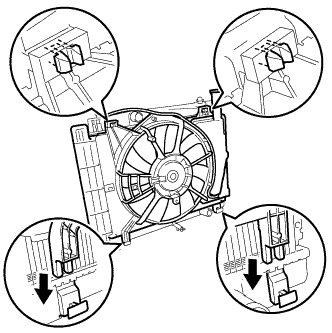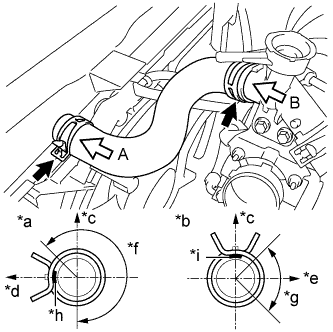COOLING FAN MOTOR (for Hatchback) > INSTALLATION |
| 1. INSTALL COOLING FAN MOTOR |
Install the cooling fan motor with the 3 screws.
- Torque:
- 3.9 N*m{ 40 kgf*cm , 35 in.*lbf }
| 2. INSTALL FAN |
Install the fan with the nut.
- Torque:
- 6.3 N*m{ 64 kgf*cm , 56 in.*lbf }
| 3. INSTALL FAN SHROUD |
 |
Engage the 2 claws and install the fan shroud.
| 4. INSTALL NO. 3 RADIATOR HOSE |
 |
Install No. 3 radiator hose with the 2 clips.
Text in Illustration *a View A *b View B *c Upper Side *d LH Side *e RH Side *f 225° *g 90° *h Paint Mark *i Blue Mark
| 5. CONNECT RADIATOR RESERVOIR TANK HOSE |
Connect the radiator reservoir tank hose to the water filler.
| 6. INSTALL AIR CLEANER ASSEMBLY |
Install the air cleaner case onto the air cleaner bracket with the 2 bolts.
- Torque:
- 7.8 N*m{ 80 kgf*cm , 69 in.*lbf }
Engage the clamp and connect the wire harness to the air cleaner case.
Install the air cleaner element onto the air cleaner case.
Install the air cleaner cap sub-assembly with No. 1 air cleaner hose onto the throttle body assembly
Engage the 2 clamps and connect the air cleaner cap sub-assembly to the air cleaner case sub-assembly.
Tighten the hose clamp.
- Torque:
- 3.0 N*m{ 31 kgf*cm , 27 in.*lbf }
Connect the vacuum switching valve assembly connector.
Connect the mass air flow meter connector.
Engage the 2 clamps and connect the wire harness to the air cleaner cap sub-assembly and vacuum switching valve assembly.
Connect the No. 2 fuel vapor feed hose to the intake manifold.
Connect the fuel vapor feed hose assembly to the No. 1 air cleaner hose and vacuum switching valve assembly with the 2 hose clamps.
Engage the clamp and connect the fuel vapor feed hose assembly to the No. 1 air cleaner hose.
| 7. ADD COOLANT |
Tighten the cylinder block drain cock plug and the radiator drain cock plug.
- Torque:
- 13 N*m{ 133 kgf*cm , 9.6 ft.*lbf }
Pour engine coolant into the radiator assembly until it is full.
- Standard capacity:
- 5.0 liters (5.3 US qts, 4.4 Imp. qts)
- NOTICE:
- Do not substitute water for coolant.
- HINT:
- Use of improper engine coolant may damage the engine coolant system.
- Use only Toyota Super Long Life Coolant or similar high quality ethylene glycol based non-silicate, non-amine, non-nitrite, and non-borate engine coolant with long-life hybrid organic acid technology (coolant with long-life hybrid organic acid technology consists of a combination of low phosphates and organic acids).
Check the coolant level inside the radiator assembly by squeezing the No. 2 radiator hose and the No. 3 radiator hose several times by hand. If the coolant level goes down, add engine coolant.
Install the water filler cap sub-assembly securely.
Slowly pour coolant into the radiator reservoir until it reaches the FULL line.
Bleed air from the cooling system.
Warm up the engine until the thermostat opens.
While the thermostat is open, circulate the coolant for several minutes.- HINT:
- The thermostat open timing can be confirmed by pressing the No. 2 radiator hose by hand, and checking when the coolant starts to flow inside the hose.
Maintain the engine speed at 2500 to 3000 rpm.
Press the No. 2 radiator hose and No. 3 radiator hose several times by hand to bleed air.
- CAUTION:
- When pressing the radiator hoses:
- Wear protective gloves.
- Be careful as the radiator hoses are hot.
- Keep your hands away from the radiator fan.
Stop the engine and wait until the coolant cools down.
If the coolant level is below the full level, perform steps (b) through (g) again and repeat the operation until the coolant level stays at the full level.
Recheck the coolant level inside the radiator reservoir tank assembly. If it is below the full level, add coolant.
| 8. INSPECT FOR COOLANT LEAK |
- CAUTION:
- To avoid the danger of being burned, do not remove the water filler cap sub-assembly while the engine and radiator assembly are still hot. Thermal expansion will cause hot engine coolant and steam to blow out from the radiator assembly.
Fill the radiator assembly with engine coolant, then attach a radiator cap tester.
Text in Illustration *1 Radiator Cap Tester
 |
Pump the tester to 137 kPa (1.4 kgf/cm2, 19.9 psi), then check that the pressure does not drop.
If the pressure drops, check the hoses, radiator assembly and water pump assembly for leakage. If there are no signs or traces of external engine coolant leakage, check the heater core, cylinder block and head.
